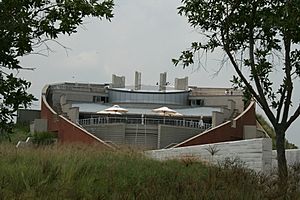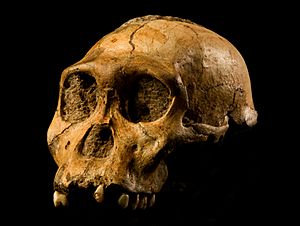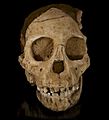Cradle of Humankind facts for kids
Quick facts for kids Cradle of Humankind * |
|
|---|---|
|
The Cradle of Humankind is a very important World Heritage Site. It was first recognized by UNESCO in 1999. This special place is about 50 kilometres northwest of Johannesburg, South Africa. It is in the Gauteng province and covers a huge area of 47,000 hectares (about 180 square miles).
This site is famous for its limestone caves, like the Sterkfontein Caves. Many old fossils of early humans have been found here. For example, in 1947, a 2.3-million-year-old fossil called 'Mrs. Ples' was discovered. It was an Australopithecus africanus. Before that, in 1924, the skull of a young Australopithecus africanus called 'Taung Child' was found at Taung.
The name Cradle of Humankind means "where humanity began." This is because the site has given us many of the oldest human-like fossils ever found. Some of these fossils are as old as 3.5 million years! Sterkfontein Caves alone have more than one-third of all early human-like fossils ever discovered.
Contents
Discoveries of Early Humans
Scientists are always finding new things at the Cradle of Humankind. In 2008, parts of several skeletons of a new species were found near Johannesburg. This species is called Australopithecus sediba. These fossils are about two million years old.
Scientists have studied these skeletons closely. They found that Australopithecus sediba had a mix of features. Its pelvis (hip bones), hands, and teeth were similar to humans. But its feet were more like a chimpanzee's. This suggests that some early human-like species could climb trees, some could walk on the ground, and some could do both!
Important Fossil Caves
The Cradle of Humankind has more than 36 caves where fossils have been found. Here are some of the most famous ones:
- Bolt's Farm
- Cooper's Cave
- Drimolen
- Gladysvale
- Gondolin
- Haasgat
- Kromdraai
- Makapan valley
- Malapa Fossil Site
- Minaars Cave
- Motsetsi
- Plovers Lake
- Rising Star Cave
- Sterkfontein
- Swartkrans
- Wonder Cave
How Fossils Are Formed

The early human-like fossils at the Cradle of Humankind are found inside caves made of a rock called dolomite. These fossils are often covered in a mix of limestone and other dirt. This mixture is called breccia. Over a very long time, the bones and breccia turn into fossils. Early humans probably lived all over Africa. But their remains are only found in places where the conditions were right for fossils to form and be kept safe.
Visiting the Site
The Cradle of Humankind is a great place to visit and learn about our past. On December 7, 2005, the South African President Thabo Mbeki opened the Maropeng Visitors Centre. This center helps people understand the amazing discoveries made at the site.
Images for kids
-
Australopithecus africanus (reconstruction)
See also
 In Spanish: Cuna de la Humanidad para niños
In Spanish: Cuna de la Humanidad para niños





